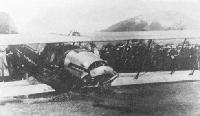Фотографии
-
John Alcock stowing away his thermos flask of coffee ready for the transatlantic flight attempt on June 14, 1919. Brown can he seen passing up the chocolate and other provisions.
Самолёты на фотографии: Vickers Vimy / FB.27 - Великобритания - 1917
-
The Vimy production line at Brooklands in April 1919 with Vimy fuselage No.13 at the far right. This example was chosen to he modified for the transatlantic attempt. The shop manager strung up some little flags above the Vimy to mark the occasion.
Самолёты на фотографии: Vickers Vimy / FB.27 - Великобритания - 1917
-
The Vimy crated lip and transported by horse and trailer to the field at Quidi-Vidi, St John's, Newfoundland. This was the field chosen by the Martinsyde crew. When the 'Raymor' crashed, Raynham kindly offered the field for the Vimy team to share while the Martinsyde crew tried to rebuild their damaged aeroplane.
Самолёты на фотографии: Vickers Vimy / FB.27 - Великобритания - 1917
-
A large tent was still not large enough to act as a hangar for the Vimy, which had to he totally reassembled out in the open air.
Самолёты на фотографии: Vickers Vimy / FB.27 - Великобритания - 1917
-
The weather was so bad that special screens were erected to keep the wind and rain off the mechanics and riggers as they reassembled the Vimy.
Самолёты на фотографии: Vickers Vimy / FB.27 - Великобритания - 1917
-
May 18, 1919, Hawker and Mackenzie-Grieve take off in the Sopwith Atlantic just before dropping the undercarriage into the sea to allow better speed and less drag during the flight to Brooklands where they were headed. Hawker flew 1,400 miles (2,253km) across the Atlantic before an engine coolant problem caused him to ditch in the Ocean, they were picked up by a Danish steamer 'Mary' and brought home to safety a week later. No-one knew they had survived as there was no radio onboard the ship.
Самолёты на фотографии: Sopwith Atlantic / Wallaby - Великобритания - 1919
-
The Martinsyde 'Raymor' after its crash on the third attempt at a takeoff. The crosswind was too strong to allow it to take off fully loaded with oil and fuel for the transatlantic flight. Morgan was injured by glass from the broken compass and had to go to hospital, Raynham was OK and with the Martinsyde crew tried to rebuild the aircraft for a second attempt at the flight.
Самолёты на фотографии: Martinsyde F.4A / F.6 / A - Великобритания - 1919
Статьи
- Round-Out
- The Roundels File
- A.Pelletier - Bombers as Postman /Between the wars/
- C.Curry - Another Alcock Album /Pioneering day/
- D.Willis - Military Auster A to Z /Production and industry/ (2)
- E.Gandet, M.Rey - Alpine Antiques /History on the wing/
- G.Cruz, P.Hebrero - Spain's Big 'boats /Flying-boats and floatplanes/ (1)
- L.Hellstrom - Imperial Fireflies /Air forces and air arms/
- M.Huggins - A 'Zero' by any other Name /World war two/
- S.Gifford - Hurricane Swansong /Post-war combat/ (2)
- S.Semerdjiev - Bulgarian Arado /Museum pieces/






